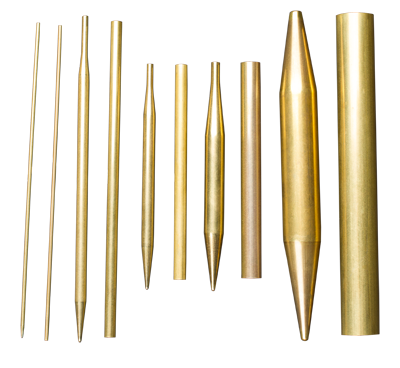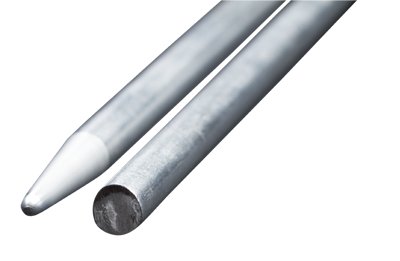Do you need a quotation or advice about our processes and services?
Our technical project manager Caroline Deutschmann, is happy to answer any of your questions.
Contact her directly at +49 (0)2352 9781 0.

SWAGING
SWAGING
Seltertech can process between 1.5 mm and 15 mm in diameter during the swaging process. The length range we cover starts from 85 mm to 400 mm – our standard ranges. However, we can process additional diameters and lengths, upon request.
The work piece is moved continuously through the oscillating tools in an axial direction during swaging. The largest part of the formation work is done in the inlet cone, which subsequently calibrates the finished cross-section. The actual feed movement pulsates each time, if the tools are not engaged. The length of the transformation is random. A calibration plate is located between the external ram and the tool in the reducing head. With this process variant, the transition angle can be generated to approximately 10°.
ESSENTIALS OF SWAGING
PROCEDURE
Swaging is a process used for a precise formation of pipes, bars, and wires. It belongs to the category of net-shape forming processes, by which it is characterized, so that the final contour of the formed work pieces is achieved with no or minimal additional processing.
TECHNICAL PARAMETERS
Seltertech can swage material of 1.5 mm to 15 mm in diameter. The length range, we cover lies between 85 mm and 400 mm. These dimensions are our standard ranges. Additional diameters and lengths, can be processed upon request.
In the swaging process, the forming tools are centred around the workpiece. The tools oscillate at high frequency with a short stroke. The stroke rate, depending on machine type, is between 1500 and 10000 min-1, while the total strokes are between 0.2 and 5 mm. The tool engagement usually occurs simultaneously. In most cases, there is a tool set of two or four segments. Depending on the application and size of the machine, divisions of two to eight segments can be achieved. To prevent the material from flowing into the gap between the tools, it must be ensured that the rotational movement takes place between the tool and work pieces. This happens when the workpiece revolves around or rotates between the tools. The rotational movement is not necessary for non-rotationally symmetric parts during production.
MATERIAL FLOW
Swaging is an incremental process. That means the conversion is completed in many small steps. The incremental forming processes as oppose to the continuous process, creates the advantage of enabling a more homogeneous formation of the material. Swaging therefore allows high degrees of forming, because the formability of the material is utilized uniformly throughout the cross-sectional component.
A second advantage of incremental forming is the minimization of friction. The tool is engaged only briefly. During this procedure, there are only slight shifts between the work piece and tool. The thrust forces are absorbed by the elasticity of the work piece. To create formations by swaging, it is enough to apply oil lubrication to the enclosed circuit. This stabilizes the temperature and cleans the machine.
ADVANTAGES OF SWAGING
Net-shape production, Ready-to-install precision
Achievable tolerances are so narrow that subsequent machining is unnecessary in most cases. In effect, materials can be conserved and the process chain can be shortened. This also results in low unit costs.
High potential for different forms, Weight optimization
Rotary swaging enables the creation of a very diverse formation spectrum for both external and internal workpieces. On average, weight saving for swaged components lies between 30% and 50% when compared to conventional production.
Good component quality
Swaging facilitates continuous interfibre structure on the workpiece. The cold work hardening of materials formed by reshaping, can be used to strengthen the component. The surface quality produced by swaging has the same standard as polished surfaces.
High levels of forming, Machining brittle materials
Swaging can be used to produce a high degrees of forming without heat treatment. It is therefore, suitable for reshaping brittle materials due to the low state of stress during forming and the homogeneity of the forming processes.
Cold and hot forming
Due to the application of radial forces, this method can be used in cold, warm or hot temperatures.
Environmentally friendly
In contrast to most forming processes, the work pieces do not require a layer of lubricant carrier. The coolant, if required, is within an enclosed circulation.
High flexibility
Rotary swaging machines are quickly convertible. The tool exchange and its adaptation to a new component is usually completed within a few minutes.
Short cycles, High availability
Due to their horizontal layout and relatively low space requirement, swaging facilities are combined into effective transfer systems where high volumes are manufactured in several layers. A robust and maintenance-friendly design ensures high availability.
GUSTAV SELTER GmbH & Co. KG
Hauptstraße 2 – 6
58762 Altena
Germany
© COPYRIGHT 2016-2023 GUSTAV SELTER GMBH & CO. KG



